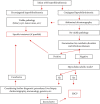Conjugated Hyperbilirubinemia in Infants: Is There Still a Role for ERCP?
- PMID: 34258256
- PMCID: PMC8249117
- DOI: 10.1155/2021/9969825
Conjugated Hyperbilirubinemia in Infants: Is There Still a Role for ERCP?
Abstract
Over a twenty-year period, we performed 255 ERCP procedures in infants aged up to 1 year. ERCP was indicated in cholestatic infants with suspicion of biliary obstruction. The most common diagnosis was biliary atresia (48%), choledochal cysts (13%), and choledocholithiasis (4%). The procedure complication rate was 13.7%. Hyperamylasemia occurred in 12.9%. More severe complications were rare-0.8% of ERCP procedure. There were no cases of postprocedural pancreatitis or death. Our study has proved that ERCP is a safe and reliable method in this age group. Its high specificity and negative predictive value for extrahepatic biliary atresia can prevent unnecessary surgeries in patients with normal bile ducts or endoscopically treatable pathologies.
Copyright © 2021 Jan Stovicek et al.
Conflict of interest statement
The authors declare that they have no conflicts of interest.
Figures
References
-
- Moyer V., Freese D. K., Whitington P. F., et al. Guideline for the evaluation of cholestatic jaundice in infants: recommendations of the North American society for pediatric gastroenterology, hepatology and nutrition. Journal of Pediatric Gastroenterology and Nutrition. 2004;39(2):115–128. doi: 10.1097/00005176-200408000-00001. - DOI - PubMed
-
- Serinet M. O., Wildhaber B. E., Broue P., et al. Impact of age at Kasai operation on its results in late childhood and adolescence: a rational basis for biliary atresia screening. Pediatrics. 2009;123(5):1280–1286. - PubMed
MeSH terms
LinkOut - more resources
Full Text Sources
Medical





